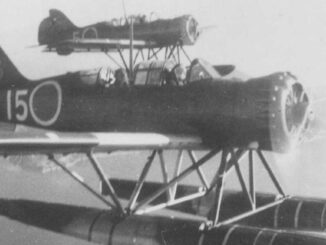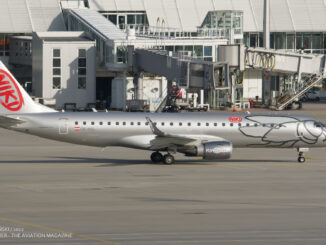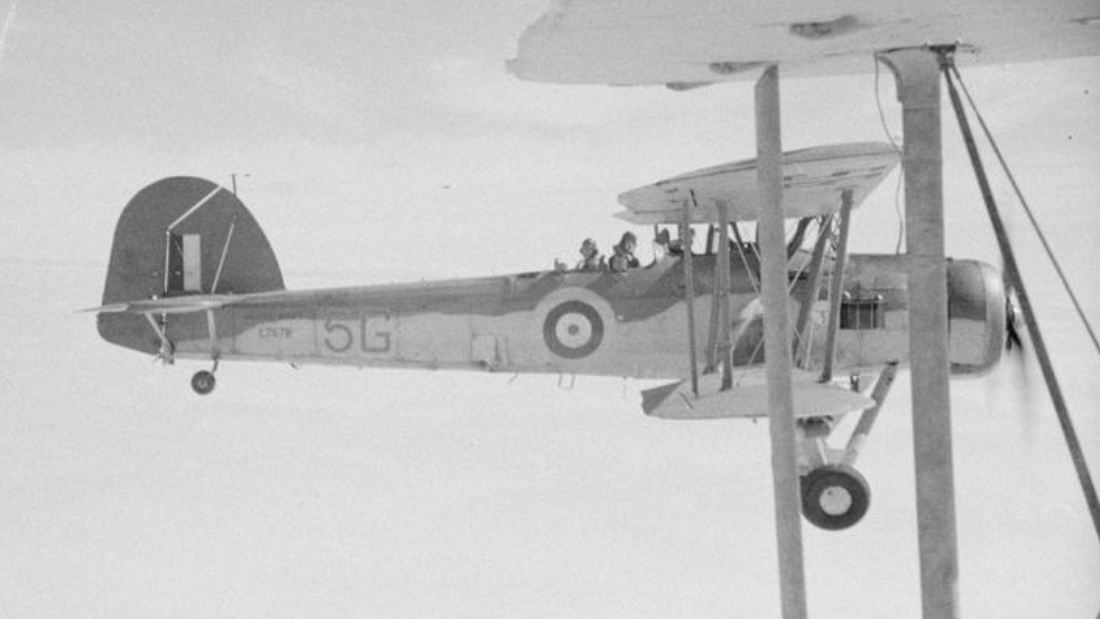 On 26th May 1941, Fairey Swordfish aircraft launched from HMS Ark Royal aircraft carrier hit German battleship Bismarck with two torpedoes, damaging her stern and making the ship unmanoeuvrable.
On 26th May 1941, Fairey Swordfish aircraft launched from HMS Ark Royal aircraft carrier hit German battleship Bismarck with two torpedoes, damaging her stern and making the ship unmanoeuvrable.
The story of pursuit of one of the most feared German warships, the Bismarck battleship, is one of the most famous operations of the World War II. Although it was already told in many movies, books and historical studies – definitely exceeding the scope of a single feature article by its volume – it is still worth mentioning within our weekly aviation history series.
Bismarck was launched on 14th February 1939, as the first of only two Bismarck-class battleships of Kriegsmarine, naval forces of the Nazi Germany (the second one was Tirpitz, launched in April of the same year). They were the heaviest battleships ever built for a European navy and soon after became a legend, elicits fear among the Allied military and merchant vessels.
What´s more, the German battleships did not have to enter any real combat to achieve that. For example, the simple presence of Tirpitz in Norwegian fjords resulted in the necessity to keep in readiness adequate equivalent of the Allied naval forces nearby, to counter any possible attack and, in addition, invoked fear among personnel of the Arctic convoys.
At the beginning of 1941, the German Oberkommando der Marine – OKM (English: naval high command) came up with an idea to use its heavy warships as raiders against the Allied fleet and merchant convoys in the Atlantic Ocean. From January to March of 1941, two Scharnhorst-class battleships – Gneisenau and Scharnhorst were deployed to the North Atlantic, for a raid codenamed Operation Berlin. It was a pretty successful operation as the German battleships managed to sink or capture twenty-two Allied vessels, without any losses.

The next raid had to be significantly more impressive. It was initially scheduled to begin in April of 1941 and had to include all four German major battleships: Gneisenau, Scharnhorst, Tirpitz and Bismarck. However, the two ships that participated in Operation Berlin were undergoing some necessary repairs in Brest, France, where they received further damage from the British bombers. Tirpitz was not yet completed for such raid. What´s more, two other German battleships, Admiral Scheer and Admiral Hipper were also under repairs. Therefore, the only two heavy ships available at the end of April were Bismarck and Prinz Eugen, the heavy cruiser launched in August of 1938.
Despite the abovementioned issues, Admiral Erich Reader, commander of the OKM, insisted on performing the raid as planned, even with the only two ships available at that time. His decision was supported by Adolf Hitler and other high-ranked Nazi officials. Eventually, on 18th May 1941, Bismarck and Prinz Eugen sailed away from Gotenhafen (now Gdynia in Poland) and headed the North Sea. Operation Rheinübung (English: Rhine exercise), as the raid was named, officially began.
On 21st May, the British Admiralty was informed that German battle group left the Danish Straits. Almost immediately, all the British warships already at sea were alarmed. Several cruisers were sent north to patrol waters between the British Islands and Greenland.
From the very beginning, naval aviation played an important role in searching and following Bismarck. Already on 21st May, the German battleship was positioned and photographed by a Spitfire from the Coastal Command. Shortly after, combat engagements were to come.
On 23rd May, the German ships were spotted by HMS Suffolk and HMS Norfolk, the two Royal Navy cruisers on patrol in the Denmark Strait. Early the next day, Bismarck and Prinz Eugen were intercepted by the Royal Navy battleships, HMS Hood and HMS Prince of Wales. An artillery duel began shortly after but, regrettably for the Royal Navy, the Battle of the Denmark Strait ended with explosion of Hood that almost immediately sank with her entire but three crew of 1,418 sailors. For the German ships, the way to the Atlantic Ocean was open.
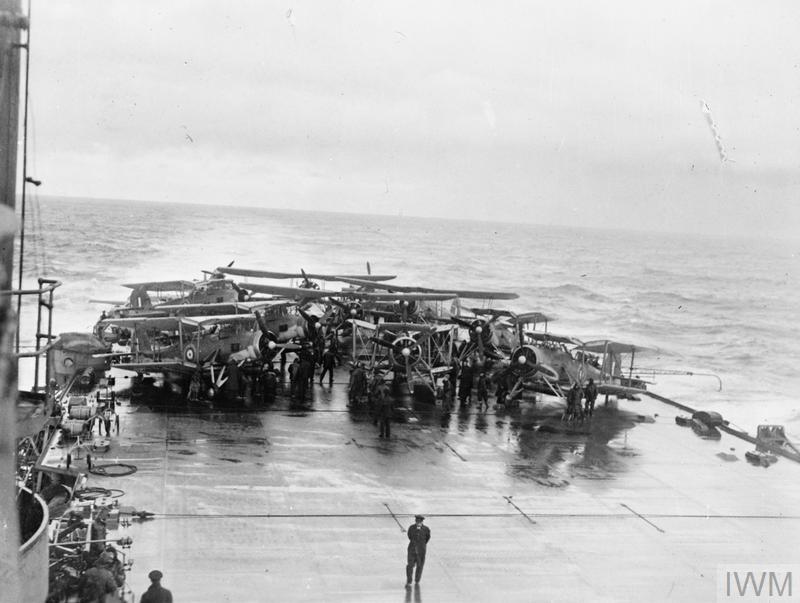
Sinking of the HMS Hood was the tragedy for the entire country. Moreover, it was a slap in the Royal Navy´s face as the battlecruiser was among the most famous and most prestigious ships within the British naval forces. An order for all British warships in the area to join the pursuit was issued by Winston Churchill himself. ´Sink the Bismarck!´ was not a mere order, it immediately became a national goal.
In the meantime, Admiral Günther Lütjens, commander of the German battle group, had to deal with one critical issue. Bismarck was also damaged during artillery duel with Hood and Prince of Wales, the German battleship was leaking oil and her speed dropped significantly. Aware of being chased by the Royal Navy, Lütjens decided to detach Prinz Eugen for a lonely raid in the Atlantic, then set the course to France. He wanted to reach Brest and expected, when approaching the French coast, to soon receive air cover from the Luftwaffe.
In the late evening of 24th May, the first air attack on Bismarck occurred. It was made by nine (or eight, according to some sources) Fairey Swordfish torpedo bombers of No. 825 Naval Air Squadron, launched from HMS Victorious and led by Lt. Com. Eugene Esmonde.
The Fairey Swordfish was a biplane torpedo bomber developed in the early 1930s. However, in times of the World War II, with its classic biplane design with open cockpit, struts and braces, as well as maximum speed of about 230 kph, the aircraft was more than obsolete. Nevertheless, no attempt to replace the Swordfish with much modern design was successful enough and the slow biplane stayed in operational service until the end of the war.
One of the most important advantages of the Swordfish was its versality. Initially, the biplane was developed as a torpedo bomber and reconnaissance aircraft. Nevertheless, during its operational career the Swordfish was also used as dive bomber, anti-submarine aeroplane, close support aircraft and in many other roles. It was exactly its legendary versality that gave the Swordfish its nickname – ´Stringbag´. Like a string shopping bag, popular at the time, the biplane was able to carry literally any weapon or equipment.
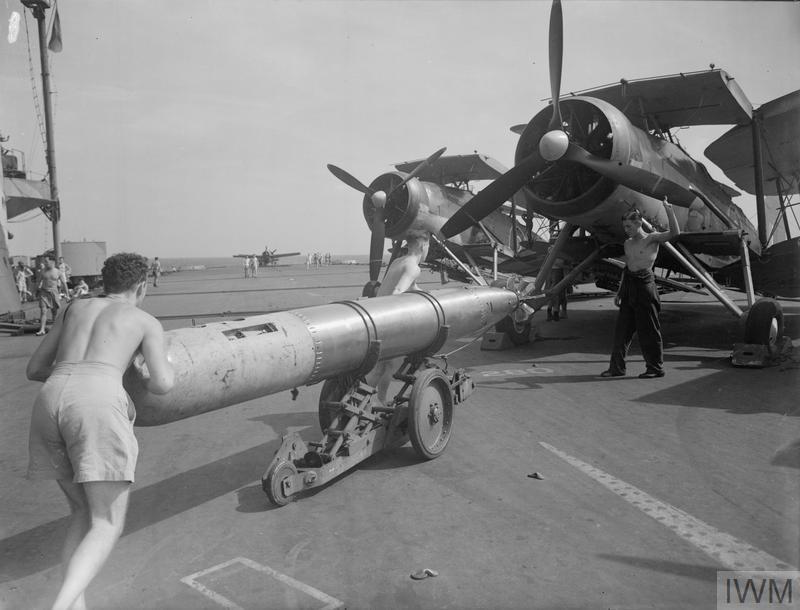
Eventually, the Swordfish remained in production as long as August of 1944. There were approximately 2,400 aircraft of that type manufactured until that time. According to the biplane monograph written in the early 1970s by Ian G. Scott, the Swordfish sank a greater tonnage of Axis shipping than any other Allied aircraft during the war.
During their first torpedo attack on Bismarck, the British biplanes, despite night and severe weather conditions, managed to hit the German ship with one torpedo. However, it made almost no damage and killed just one German sailor. Soon after, the Royal Navy ships shadowing Bismarck lost contact with the German battleship. Immediate searching brought no results and it seemed Bismarck would be able to reach Brest soon.
Fortunately for the Royal Navy, on 26th May in the morning, Bismarck was found by PBY Catalina flying boat operating from Northern Ireland. The battleship was still more than a thousand kilometres from the French coast and, most importantly, still beyond range of German air cover.
Shortly after, two Swordfish biplanes from HMS Ark Royal carrier joined Bismarck and followed her from safe distance. In the afternoon, HMS Sheffield arrived to the scene and began to shadow the German battleship.
In the meantime, air attack was launched from Ark Royal. Her Swordfish biplanes, being unaware of Sheffield following the German battleship, mistook the cruiser for Bismarck and attacked her with torpedoes. The first aircraft missed the target and then, luckily, the ship was eventually recognized by the Swordfish as the British cruiser.
The second attack from Ark Royal came around 9 p.m. on the same day. It was carried by fifteen Swordfishes from Nos. 810, 818 and 820 squadrons. Flying in the night and severe weather conditions, the Royal Navy biplanes managed to reach Bismarck and hit her with two, or three, torpedoes. One of them hit the battleship at the stern in the starboard side. It was a critical hit – both rudders of Bismarck jammed at 12º to port. The German battleship was no longer able to follow any course and, as a consequence, neither reach Brest nor escape the pursuit.

Next day in the morning, Bismarck was caught by HMS Rodney and HMS King George V battleships. The British ships opened fire from safe distance and, after approximately half an hour, silenced the main guns of Bismarck. Then, as the British battleships were nearly out of fuel, a torpedo attack was made by HMS Dorsetshire heavy cruiser. Three torpedoes hit Bismarck and at 10:40 a.m., the German battleship sank. There were only about one hundred survivors rescued, more than 2,000 sailors died with the ship, including Admiral Lütjens.
In September of 1941, the Admiralty announced about awarding some of the Swordfish crew members for their successful engagement with Bismarck. The list included Lt. P. D. Gick, awarded Distinguished Service Cross; Lt. Com. Eugene Esmonde, awarded Distinguished Service Order; Sub Lt. V. K. Norfolk, awarded DSC; A/PO Air L. D. Sayer, awarded Distinguished Service Medal; A/Ldg Air A. L. Johnson, awarded DSM. They were met by Admiral Somerville who personally congratulated them for the role they played in the sinking of Bismarck.
After separating from Bismarck, Prinz Eugen headed south to continue her solo raid. Nevertheless, due to engine issue that occurred on 27th May, speed of the cruiser was significantly reduced. Prinz Eugen was forced to abandon the raid and return to Brest that she reached on 1st June.
In February of 1942, Prinz Eugen, together with two other German warships Gneisenau and Scharnhorst made a successful attempt to escape Brest and sailed through the English Channel back to Germany. That operation – officially named Unternehmen Zerberus (English: Operation Cerberus) or Operation Fuller, but commonly known as the Channel Dash – turned out to be fatal for Lt. Com. Esmonde. The brave Irish pilot and his crew died while performing a torpedo attack on the German ships, being shot down by an enemy fighter aircraft.

Cover photo: A Fairey Swordfish from HMS Ark Royal aircraft carrier, April 1941. © IWM A 3820. All IWM photos used under Non-Commercial licence.


